Busm2580 module 01 slides
Bạn đang xem bản rút gọn của tài liệu. Xem và tải ngay bản đầy đủ của tài liệu tại đây (2.74 MB, 44 trang )
RMIT Classification: Trusted
Integrated Perspectives on
Business Problems
Week 1: Introduction to a
Business Problem
1
RMIT Classification: Trusted
Welcome to Integrated Perspectives on
Business Problems!
2
2
RMIT Classification: Trusted
More about
your lecturer
▪ Access Canvas, “Getting
Started” module to know more
about your lecturer.
3
3
RMIT Classification: Trusted
Week 1 overview.
• Introduction to course.
• Overview of outcomes and assessments.
• Expectations and resources.
• What is a problem?
• Business problems.
• Business Model Canvas.
• PESTLE Analysis.
4
4
RMIT Classification: Trusted
—
Course overview
5
RMIT Classification: Trusted
Course Learning Outcomes.
•
CLO1: Integrate and apply foundational multi-disciplinary theory, frameworks, skills and
techniques to define and address a problem or an opportunity.
•
CLO2: Demonstrate research and problem-solving skills in the context of solving an
authentic business problem.
•
CLO3: Work collaboratively to identify stakeholders and to position the proposed research
in relation to the field of expertise or practice.
•
CLO4: Reflect and document personal strengths so as to begin to develop a personal and
professional brand and identity.
•
CLO5: Identify the optimal mode or forum of delivery and communicate integrated
business perspectives in coherent and compelling ways.
6
6
RMIT Classification: Trusted
You’ll learn this course through 4 phases:
Phase 1 - Pre-class Activities
(Self Study): to be completed at
home to prepare for in-class
activities (~3 Hours).
Phase 2 – One-hour Online
Class: practical activities to
discuss and review weekly topics
and prepare for assessments (1
Hour).
Phase 3 – Two-hour on
campus class : practical
activities to apply weekly topics
into real business scenario and
prepare for assessments (2
Hours).
Phase 4 - Post-class Activities:
follow up and reflection activities
(~2 hour).
Always read the Canvas announcements.
77
RMIT Classification: Trusted
3 Assessments:
Assessment Type
Task 1: Business
Individual
Analysis
video
Presentation
presentation
% Grade
20%
When? More info
Week 6
Practice the skill of comprehending and defining business
Sunday
problems of a real company using the design thinking
technique and students' understanding of internal and
external factors in the company's business environment.
Task 2: Problem
Individual
Solving Skills and
online quiz
40%
Week 10
Wednesday
Reflection
Demonstrate your understanding of the multidisciplinary
theories, frameworks, and techniques that you have
learned in the course and to apply them to different
contexts, to demonstrate your research and problemsolving skills in examining, developing, and justifying
solutions to business problems.
Task 3: Business
Group paper
Solution Design
(4,500 words)
40%
Week 12
To demonstrate your ability to apply multidisciplinary
Sunday
theories, frameworks, and techniques that you have
Report
learned in the course to different contexts, to demonstrate
your research and problem-solving skills in examining,
developing, and justifying solutions to business problems.
8
8
RMIT Classification: Trusted
Assessment policies.
All the information is here:
If you need more information, go to
the RMIT assessment policies page.
/>
9
9
RMIT Classification: Trusted
Where is the info?
Canvas!
You will find all the materials
guidelines, assessments,
discussions and support here.
10
10
RMIT Classification: Trusted
Important apps for your studies.
Microsoft 365.
11
11
RMIT Classification: Trusted
Where can I find more resources?
LinkedIn Learning!
• Sign in with your s-number.
• You can also download the
app.
/>
12
12
RMIT Classification: Trusted
Questions?
13
13
RMIT Classification: Trusted
—
Problems!
14
RMIT Classification: Trusted
Consultants.
1. Write one problem or concern
you currently face at the top of a
piece of paper (2 mins).
2. Pass your paper to the student
on your left.
3. Read the problem in front of you
and write some advice (1 min).
4. Repeat (1 min).
15
15
RMIT Classification: Trusted
Discussion.
• Did you get one or more ideas that will truly help you
resolve your issue?
• How did you feel having to give advice?
• Why do we not ask each other for help more often?
• What implications does this have for us back on the job?
16
16
RMIT Classification: Trusted
—
Business Problems
17
RMIT Classification: Trusted
Business problems.
A problem represents a discrepancy
between the actual state of the
business and their desired state.
This discrepancy requires attention
and response, even if that response
is no action at all.
18
18
RMIT Classification: Trusted
Let’s solve a problem in
small groups.
6. Evaluate
& monitor
the
process
Your workplace does a lot of printing.
Often things are only printed for one
1. Identify
the
problem
meeting, and you think a lot of paper
is being wasted. Everyone buys their
5.
Implement
a solution
plan
lunch in plastic containers and eat
Steps in solving a problem
with plastic cutlery. There also isn’t
any recycling or food waste bins in the
office.
4. Select
the best
solution
19
19
3.
Brainstorm
solutions
2. Identify
the causes
RMIT Classification: Trusted
Reflecting on problem solving.
• Why is it important to consider a range of solutions for
complex problems?
• How do you know whether your solutions are feasible?
• Why are causes and effects a critical part of
understanding complex problems?
• How does working in group impact coming up with
solutions to problems?
20
20









